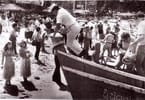Paso Robles (means Oak Pass), CA has emerged as a perfect destination for oenophiles and wanna-bees. Located between Los Angeles and San Francisco, Paso is noted as a US leader in Rhone varietals and offers unlimited access to wines that are equal to or better than wines from any other part of the planet. With 32,000 vineyard acres, 11 diverse viticulture areas, 40 different grape varieties, 250 wineries with approximately two-thirds open for tastings, this destination is fabulous for wine tourists.
Getting To Paso
The closest airport is San Luis Obispo County Regional (SBP) served by regional airlines through Los Angeles, San Francisco and Phoenix. Located 2.5 hours by car from Paso Robles, the Norman Y. Mineta San Jose International Airport (SJC) is the closest major airport. The locale is also part of the Amtrak program and the Coast Starlight and the Amtrak Thruway bus connects to the Pacific Surfliner in San Luis Obispo. Driving? Paso is off US Hwy 101, 110 miles from Bakersfield, 158 miles south of San Jose, 204 miles from San Francisco, and 207 miles north of Los Angeles.
Wines of the Locale
• Red
1. Carignane. High acidity, color and tannin. Planted with Petit Sirah and Zinfandel. In wine making the grape is frequently used as a deep coloring component in blending. Can be challenging to use – naturally high in acidity, tannins and astringency; skill required to product a wine of finesse and elegance.
2. Cinsaut. Red wine grape with heat tolerance, aromatic and fruity. May be blended with Grenache and Carignan to add softness and bouquet. Low in tannin; added to bring a spicy note; found in Rose.
3. Counnoise. Unique red wine grape variety; late ripening; plump; thin skin; fruity; good acids, spicy; aromatic; bright acidity; soft tannins. Used in southern Rhone blends.
4. Grenache. Worlds second most popular wine grape that ripens late and needs hot, dry conditions. To the nose: Red fruit, licorice, black pepper; to the taste: cherry and spice with interestingly mild acidity; usually blended with Syrah, Carignan, Tempranillo and Cinsaut.
5. Mourvedre. Rhone varietal. Featured as a component with Grenache and Syrah; adds color, fruit and moderate tannic structure to complement fruity Grenache and elegant Syrah. Requires lots of sun and irrigation. To the nose: red fruit and chocolate, leather and earth; to the tongue: plums, currents and spiced. Used to make rose and port-style fortified wines. Ages well.
6. Petite Sirah. Developed in France by Dr. Francois Durif (1880). A combination of Syrah and Peloursin. To the eye: produces dark, inky colored wines. To the taste: bouquet has herbal and black pepper overtones; plums, blueberries relatively acidic, lots of tannin. Improves with age (think 20 years).
7. Syrah. Planted frequently in California as a Rhone varietal. To the nose: smoke, bacon, black fruit, crushed rocks; to the tongue: blue and black berries, mint and pepper, black olives and spices; to the tongue: full body, tastes of tannin that lingers.
• White
1. Grenache Blanc. To the taste: high alcohol, low acidity, green apples, lemons and suggestions of grapefruit and herbaceous notes; to the tongue: nuttiness and acidity.
2. Marsanne. To the eye – deeply colored; to the nose: herbal tea, spice, pears, honeydew melon; to the tongue: honey and spice with medium body and a finish that suggests minerality.
3. Picpoul Blanc (lip stinger). To the eye – green-gold in color; to the nose: floral, lemons and tropical fruits; to the taste – full-bodied.
4. Roussanne. To the eye – golden in color; to the nose: rose petals, honeysuckle and herbs; to the tongue: honey and pear fruit with moderate acidity.
5. Viognier. Produces full-bodied wines with lush, soft character. Wonderfully aromatic with peaches, apricots, violets and minerality; to the tongue: stone fruit and spices, ends with a memory of low acidity.
Space to Stay. Dine. Wine
One of the best place to stay, play, drink wine and dine is the outstanding SummerWood Winery and Inn. Built in 1994 as a farmhouse (known as the Arbor Inn) by the Hope family as part of Treana Winery, the property was purchased in 2000 by Japanese business executive, Kesao Fukae who renamed it SummerWood (Natsuki in Japanese). The recent renovation of the 9000 sq.ft. 9 room Inn was directed by Kelly Wangard, Professional Chef and a Winner of Cut Throat Kitchen.
Wangard designed the new interior that uses LED lighting and energy-efficient materials that are able to deal with the very warm weather. Many of the furnishings are made from recycled or salvaged materials, art work is made from reclaimed wood from a local barn and the drinking glasses are made from recycled wine bottles.
SummerWood Inn (summerwoodwine.com) guests (especially those who reserve the suite with outdoor terrace) are among the privileged few who experience a daily farm fresh cooked-to-order breakfast by Chef Kelly and her team, sip afternoon wine from the SummerWood winery, and can (with reservations), have Chef Kelly personally design luncheon and dinner menus that will meet (and exceed) every wish (from lactose and gluten free to calorie counters).
At a recent luncheon hosted at SummerWood and designed by Chef Kelly guests dined on:
• Salad Lyonnais (perfect poached egg, bacon, pomme frites, haricot vert with Dijon Vinaigrette)
• Spice Roasted Chicken with English peas
• Black bean and zucchini cake, Avocado cream and Windrose greens
• Orange – panna cotta with candied fennel, olive oil and salt cookies, berries and agave
– Wine selection
– 2013 Summerwood Vin Blanc (65 percent Marsanne; 21 percent Roussanne; 14 percent Grenache Blanc)
A Sip Away
A few steps away from the SummerWood Inn, guests enjoy the tasting room. The talented Chilean winemaker, Mauricio Marchant, is the magician steering the winemaking process. The wines are available for purchase through SummerWood and membership in the wine club.
At a recent tasting:
• 2013 Grenache Blanc (Best of Class/Gold Medal Winner – 2014 Central Coast Wine competition). $25 +/-
Golden to the eye; to the nose: flowers, pears, honeydew and guava; to the palate: green apples and pears with a hint of spiciness leaving a refreshing and slightly bitter (think lemons, lime and a hint of under-ripe grapefruit) memory. Aged in French oak for 6 months (70 percent); concrete vessel (30 percent).
• 2011 Diosa. 82 percent Syrah, 15 percent Mourvedre, 3 percent Grenache $60 +/-
To the eye a ruby cherry red; to the nose – think blackberries, dark chocolate and oak along with cherries, chocolate, leather and coffee. Deep almost sour finish with tannins that are memorable.
• Vina Robles: Wines, Tasting Room, Amphitheatre
Swiss owned, the Vina Robles (vinarobles.com) enterprise was started by Hans Nef a successful agriculture executive and civil engineer with a passion for wines. In the 1990s he began agricultural projects in Arkansas with Hans R. Michel, of Agriworld, an international agricultural consultancy and management firm. During these years Nef collected Bordeaux wines and started a wine import organization, importing select wines from California to Switzerland.
In 1996 Nels acquired viticulture land in Paso Robles and started Vina Robles winery. He planted four estate vineyards: Huerhuero, Jardine, Creston Valley vineyards and Pleasant Valley and with Hans Michel at the helm, developed the Vina Robles vineyards, supervises the operations and started Viticultural Management Inc. to work with other wineries and winegrowers throughout the Central Coast.
European Heritage with a California Attitude
The unique qualities of the Vina Robles brand comes from the link between the Old and New worlds that builds on the finesse and sophistication of European wines and the boldness of the Paso Robles estate vineyards. Vina Robles takes the complex soils and microclimates of the area to grow Cabernet Sauvignon, Petit Verdot, Syrah, Petite Sirah, Viognier, Sauvignon Blanc, etc. Wines are available domestically and internationally as well as at the winery Hospitality Center.
At a recent tasting:
– 2013 Viognier – Huerhuero (100 percent Viognier). $22 +/-
To the eye: the palest of yellow (like daisy petals); to the nose: apricots, mandarin orange peel, and honeysuckle; to the tongue: sweet pears and hint of citrus. Aged in stainless steel tanks; during fermentation portion transferred and aged for four months in neutral oak barrels. Pair with steamed mussels; cold poached salmon with dill; goat cheese salad with walnuts or spiced almonds.
– 2011 Vina Robles Suendero. 53 percent Cabernet Sauvignon; 47 percent Petit Verdot. $54 +/-
To the eye, deep purples and reds; to the nose: walnuts, dark ripe black cherries and dark chocolate; to the taste: sour cherries and slightly astringent – but opens as it mellows on the tongue. Pair with filet mignon and lamb chops.
Vina Robles Amphitheatre
Influenced by the architecture of California missions, this modern venue for live performances was designed by Heller Manus Architects, San Francisco, CA. With seating for 3000, the space is handicap accessible. Available for private events (i.e., weddings, corporate programs), the 2015 show season (developed by Nederlander Concerts), celebrity performances include Tony Bennett, Willie Nelson & Family and Ringo Starr and his All-Starr Band as well as Kenny Loggins, Crosby, Stills & Nash, The Doobie Brothers, Bonnie Raitt and the Moody Blues.
• Anglim Winery
What do you do when you are both mid-career; she has an MBA from Wharton and is a high-profile management consultant; he has an MBA from Pepperdine University, occupies a finance position in the automotive industry and you both want to do something else?
In 2002 the Aglim’s gave up corporate America for the wine industry and have never looked back. Today, The Anglim boutique winery is successful through what can be summarized as the KISS principal (Keep It simple, stupid). He works very closely with growers and selects the very best grapes – finding that the fruit determines the quality of the wine. With small annual production, Steve Anglim handles the winemaking process himself in a shared-use facility. He uses 100 percent French oak and taste-tests the process to meet his clearly imaginative and sophisticated palate. His objective is to make elegant wines that can be cellared with enough personality to be enjoyed young.
Aglim focuses on Rhone varietals and blends in addition to limited release family favorites of Pinot Noir and Cabernet Sauvignon. The wines have been awarded gold and silver medals from the San Francisco Chronicle Wine Competition and the American Fine Wine Competition. Anglim produces only 2000 cases per year. The wines are available online, at the winery and at local retailers and restaurants.
At a recent wine tasting:
• 2006 Gorgeous. Paso Robles (Fortified Dessert Wine) San Francisco Chronicle Wine Competition 2011 – Double-Gold Medal. $24 +/-
To the nose – a perfumery of almonds and dark chocolate. Wonderful and delicious to the taste thanks to hints of honey, berries, figs and chocolate. Pair with oriental chicken or fish, an apple tart and vanilla ice cream; port salud cheese and a ripe peach
• 2012 Viognier Bien Nacido Vineyard, Santa Barbara County. 100 Viognier. $28 +/-
Palest blonde to the eye. Think of lemons, grapefruits, honey and honeysuckle, white peaches and vanilla to the nose while the palate enjoys a lively acidity and minerality with fruit lingering on the tongue. Pair with roast chicken, sushi or creamy cheese. Wine Enthusiast. Fall 2014 – 90 points
• Lone Madrone
LoneMadrone.com
Since 1996 Neil Collins and his sister Jackie Meisinger have produced wines exclusively from vineyards in the limestone hills of west side Paso Robles. Collins sources grapes from family owned Paso Robles vineyards that are dry farmed and head-trained and use organic and sustainable products and methods in order to get the best of the west Paso Robles terroir. Currently producing 4000 +/- cases of wine per year, Lone Madrones vary from crisp white Spanish varietals and classic Italian Nebbiolos to unique blends.
Awarded Wine Maker of the Year 2013 San Luis Obispo County Wine Industry Awards
There is more to Lone Madrone then excellent wines, beautiful outdoor space for weddings and party celebrations; it is more than fabulous olive trees that started before time began. Lone Madrone is very much about the outstanding, charming, off-the-cuff personality of Neil Collins. Collins, originally from Bristol, England, started his career as a chef and expanded into winemaking in the 1990s with Adelaida Cellars and Wild Horse Winery & Vineyards.
Seeking more experience, he moved his family to southern France in 1997 and joined the Chateau de Beaucastel, one of the oldest and most highly regarded estates in France. Upon his return to Paso Robles he became the winemaker and vineyard manager at Tablas Creek Vineyard, the California property of Chateau de Beaucastel. Collins has been the guiding hand bringing awards to the Tablas Creek Vineyard. He opened Lone Madrone opened in 1996.
Awards galore: 2008, 2009 Lone Madrone Rose. San Francisco Wine Competition, June 2009, Silver Medal; 2007, 2010. The Will. San Francisco Chronicle Wine Competition, January 2012. Gold Medal; 2006 Points West Roussanne – San Francisco Chronicle Wine Competition, January 2009, Silver Medal; 2006 Lone Madrone Bailey Ranch Zinfandel. San Francisco Chronicle Wine Competition, January 2009 Gold Medal.
• Bristols Cider House
BristolsCider.com
Perhaps cider never went away – but it is back and available in ever growing venues in Paso Robles. Part of Lone Madrone Winery, the Bristols Cider House is owned and operated by brother and sister Neil and Jackie and Neil’s wife Marci. In 1994 Neil began making small batches of cider from local apples under the Bristols name which evolved into a small line of ciders that are made from local apples as well as Oregon. Bristols is the only cidery on California’s Central Coast and can be found in an industrial park approximately ½ mile south of Atascadero Outlets. This gluten free product can be experienced at the production facility and tasting room.
The cider is made from apple juice and fermented on the yeasts of the fruit. Fermentation takes places in different casks such as retired Bourbon and white wine while most are fermented in stainless steel.
At a recent tasting:
• Rackman. 100 percent Braeburn. Dry hopped with citrus and Amarillo hops
Pale yellow to the eye, lemons and grape fruits to the nose leading to a delicious fruity pineapple/lemon experience to the palate.
• Black Beard. 100 percent Arkansas Black apples. Aged for 8 months in old bourbon barrels. Bottle finished with a blend of 80 percent Champagne yeast; 20 percent brettanomyces yeast for secondary fermentation.
Why Go
Go to Paso Robles for the beauty of the locale, the deliciousness of the fruit-forward wines and ciders and above everything else – the people who live and work in this part of the world. This is a destination that demands frequent returns.
WHAT TO TAKE AWAY FROM THIS ARTICLE:
- Built in 1994 as a farmhouse (known as the Arbor Inn) by the Hope family as part of Treana Winery, the property was purchased in 2000 by Japanese business executive, Kesao Fukae who renamed it SummerWood (Natsuki in Japanese).
- Located between Los Angeles and San Francisco, Paso is noted as a US leader in Rhone varietals and offers unlimited access to wines that are equal to or better than wines from any other part of the planet.
- The locale is also part of the Amtrak program and the Coast Starlight and the Amtrak Thruway bus connects to the Pacific Surfliner in San Luis Obispo.






















